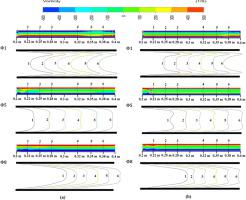Engineering Science and Technology, an International Journal ( IF 5.1 ) Pub Date : 2021-01-06 , DOI: 10.1016/j.jestch.2020.12.008 Waleed Almukhtar Allafi , Fatimah Al Zahrah Mohd Saat , Xiaoan Mao

|
Thermoacoustic system is one of the alternative technologies that provides green working principles but the lack of understanding of the complex fluid flow and energy transfer interactions within structures inside the system is leading to difficulty in accurate analysis related to the system. This study presents fluid dynamic investigation of vortex shedding and velocity profile of an oscillatory flow across a parallel-plate structure inside a standing-wave thermoacoustic system by using a two-dimensional ANSYS FLUENT CFD (computational fluid dynamics) of SST k-ω turbulence model. The model was validated using experimental data and theoretical solution. Two different operating frequencies of 14.2 Hz and 23.6 Hz were investigated with drive ratios (defined as maximum pressure amplitude to mean pressure) from 0.3% up to 3%. The results revealed that velocity profiles and boundary layers within the area of parallel-plate stack changes with time and the changes followed the cyclic travel of vortex across the structure. Two layers of vortex formed near the surface of the solid structure. These layers, known as the main and secondary vortex layers, change with the cyclic flow, and are affecting the shape of velocity profiles within the channel. The appearance of an ‘m’ shape, a ‘slug’ shape and a ‘parabolic’ shape velocity profiles are also depending on the flow amplitude (drive ratio) and flow frequency. The ‘parabolic’ velocity profile is only found for a certain moment of flow with thick boundary layer. The results indicated that fully developed flow may not be likely for cases presented in this paper. Hence care should be exercised in the use of equations during the analysis of thermoacoustic system. As the parallel-plate structure is usually an important structure of the system, a proper understanding of the dynamics of flow within this structure is crucial. These findings are expected to give better insight for future design of thermoacoustic system.
中文翻译:

具有两种不同工作频率的驻波热声系统中穿过平行板的振荡流的流体动力学
热声系统是提供绿色工作原理的替代技术之一,但是缺乏对系统内部结构内复杂的流体流动和能量传递相互作用的了解,导致难以对与系统有关的精确分析进行困难。这项研究提出的流体动力学涡旋脱落和速度分布驻波热声系统内部跨越平行板结构的振荡流的通过使用SST的二维ANSYS FLUENT CFD(计算流体动力学)调查ķ - ω湍流模型。使用实验数据和理论解验证了该模型。以0.3%到3%的驱动比(定义为最大压力幅度相对于平均压力)研究了14.2 Hz和23.6 Hz的两个不同工作频率。结果表明,平行板叠层区域内的速度剖面和边界层随时间变化,并且该变化遵循涡旋在整个结构中的周期性行进。在固体结构的表面附近形成两层涡流。这些称为主涡旋层和次涡旋层的层随循环流而变化,并影响通道内速度分布的形状。“ m”形,“弹头”形和“抛物线”形速度曲线的出现还取决于流动幅度(传动比)和流动频率。“抛物线”速度曲线仅在具有厚边界层的流动的特定时刻才发现。结果表明,对于本文介绍的案例,可能无法充分发展流程。因此,在分析热声系统时应谨慎使用方程式。由于平行板结构通常是系统的重要结构,因此正确了解该结构内的流动动力学至关重要。这些发现有望为将来的热声系统设计提供更好的见识。由于平行板结构通常是系统的重要结构,因此正确了解该结构内的流动动力学至关重要。这些发现有望为将来的热声系统设计提供更好的见识。由于平行板结构通常是系统的重要结构,因此正确了解该结构内的流动动力学至关重要。这些发现有望为将来的热声系统设计提供更好的见识。











































 京公网安备 11010802027423号
京公网安备 11010802027423号